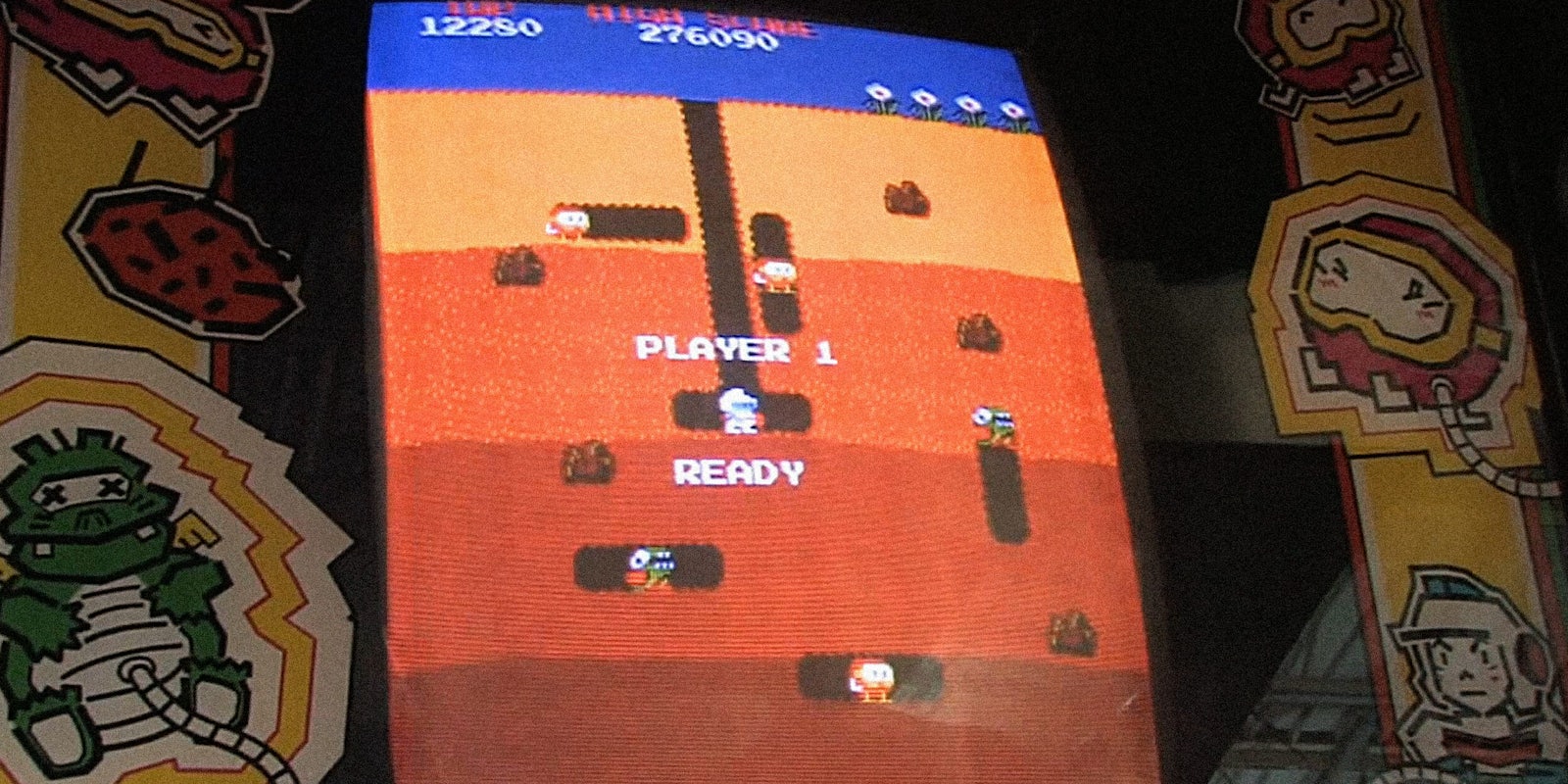We need to talk about the first episode of Stranger Things season 2. But not about the season premiere’s lingering mysteries; nor its aura of doom hovering over the town of Hawkins, Indiana; nor the appearance of ’80s sci-fi heel par excellence Paul Reiser; nor even actor Joe Keery’s spectacular hair. All that stuff is great.
We need to talk about the episode’s use of arcade classic Dig Dug, and why it bugs the hell out of me. Strap in: I’m about to make a magic xylophone complaint.
Much of the episode’s activity centers on Hawkins’ period-appropriate arcade—which, in what feels like a huge missed opportunity for a show of Stranger Things’ genre bent, does not contain a Polybius cabinet. The show’s central quartet of kids is flabbergasted when they discover Dustin’s Dig Dug high score (“DUSTIN”) has been bested by a mysterious gamer, “MADMAX,” lending the episode its title.
But as anyone who’s logged any time with Namco’s addictive 1982 classic knows, you can’t enter six characters into Dig Dug’s high score. As with most games of its era, any high scorers are limited to three characters. As any giggling teenager in 1984 would know, you could enter “ASS” or “TIT,” but “MADMAX” and “DUSTIN” would both be a no-go.
What are we, to believe this is some sort of a magic Dig Dug cabinet? Boy, I hope somebody got fired for that blunder.
This, of course, is the smallest of small complaints—almost literally so, since it’s a whine about three letters. But, like the great multitude of Star Wars fanboys over the last 40 years wincing when the Kesel Run is described as 12 parsecs, or Neil deGrasse Tyson noticing that The Daily Show’s globe spins the wrong way, I cannot let this go.
It’s because the mistake is so obvious. Stranger Things focuses such obvious care, attention, and affection on its arcade that it’s clear that the show’s staff has probably logged more than its share of hours chucking quarters into Dragon’s Lair, Pac-Man, and, yes, Dig Dug. I’d wager my own share of quarters that someone in the show’s production office, perhaps even a Duffer brother himself, has actually set a Dig Dug high score on some smoke-encrusted cabinet out in the wild.
That leads me to assume the mistake is a conscious decision. Why? It can’t be in order to play up the mystery of who set the high score because that’s resolved by episode’s end: The high scorer is Max, a taciturn new girl in town. (That the character who achieved the high score already has a three-letter name that would have worked just fine may have caused my brow to twitch involuntarily.)
Instead, my best guess is that the show features a longer-than-possible high score because the Duffer Brothers were just that eager to make a Mad Max reference, which could then double as the episode’s title. As if the idea of centering an episode on a group of kids competing over a Dig Dug high score was not itself already peak ’80s.
In essence: “Yo dawg, we put an ’80s reference in your ’80s reference so you can ’80s reference while you ’80s reference.”
I’ll stop here to emphasize that I’ve come to praise Stranger Things, not to bury it. It may not seem like it, but I love the show. It’s exciting, well-written, well-acted, and clearly made with great love. It also has some of the finest and most well-executed production design on TV. Pay special attention to the Wheeler and Byers homes, which are not lazily loaded with obvious ’80s paraphernalia but also have furnishings drawn from the ’60s and ’70s, just as a middle-class ’80s home would, and just as you’ve probably got an early-2000s IKEA table kicking around in your home now.
If the show errs in any major way, it’s probably in occasionally trying to hit that nostalgia pleasure center in the brain just a little too blatantly. It’s when it lingers on that movie theater marquee advertising The Terminator (in theaters in October 1984) too long. It’s when Mike’s room prominently features an immaculate poster of John Carpenter’s The Thing, never mind the plausibility of a 12-year-old in small-town Indiana having a poster of a not-yet-a-cult R-rated film then only a year old. It’s when the show exclaims “Hey, guys, remember the ’80s?” just a little too enthusiastically that I find myself slipping out of its world.
It’s interesting to compare Stranger Things to its unlikely counterpart of sorts, FX’s The Americans, which likewise set its most recent season in 1984. That’s a show that almost entirely sidesteps making obvious ’80s references, dropping one in only when it’s either historically relevant (like the attempted assassination of Ronald Reagan) or thematically important (like a reference to the widely watched and gloom-inspiring TV miniseries The Day After).
Instead, Stranger Things is at its best when it connects to the ’80s in ways that are more subtle and inventive—like, for example, its use of Dungeons and Dragons as a way to conceptualize the Upside Down and its monsters. When it comes to referencing the show’s beloved decade, Stranger Things should take its advice from none other than funk icon Leon Haywood and his timeless ’80s jam: “Don’t push it, don’t force it/Let it happen naturally.”
And if Dig Dug II shows up in season 3, I expect complete accuracy.
Correction: An earlier version of this article misspelled the name of actor Joe Keery.


